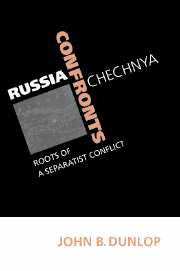1 - The Chechens' encounter with Russia
Published online by Cambridge University Press: 06 January 2010
Summary
[E]verywhere there are mountains, everywhere forests, and the Chechens are fierce and tireless fighters.
John F. Baddeley, The Russian Conquest of the Caucasus (1908)The sun had risen and its spreading rays were lighting up the dewy grass. Near by the Terek murmured in the awakening forest … The Cossacks, still and silent, stood round the dead [Chechen] … The brown body … was well-proportioned and comely. “He, too, were a man,” [the Cossack who had killed him] muttered, evidently admiring the corpse.
Lev Tolstoi, The Cossacks (1863)The Caucasus, a chain of high mountains which extends across an isthmus separating the Caspian and Black Seas, have traditionally been recognized as a key natural frontier dividing Europe from Asia. The range stretches a total of 650 miles, of which 400 miles constitute the truly mountainous part; the chain's width averages about 100 miles, except in the middle, the site of the Daryal Pass and the Georgian Military Highway, where it narrows significantly, and at the tapering extremities. The two natural routes for traversing the mountains are through the Daryal Pass and along the Caspian coast in the present-day autonomous republic of Dagestan.
The word “Chechen,” which entered Russian from a Turkish tongue, is taken from the name of a lowland Chechen village where the Russians first encountered them. The Chechens, it should be noted, do not refer to themselves by this name; rather they call themselves “Nokhchii” (singular “Nokhchuo”). The Chechens have lived in or near their present territory for at least 6,000 years.
- Type
- Chapter
- Information
- Russia Confronts ChechnyaRoots of a Separatist Conflict, pp. 1 - 39Publisher: Cambridge University PressPrint publication year: 1998



